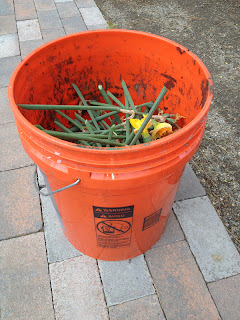Off With Their Heads!
Now that we've finally had some rain, I don't have to spend all my after-school garden time watering seeds and plants. That means that today I had time to do some deadheading in the perennial border.
Deadheading is just a colorful term for cutting dead flowers off of a plant. There's a couple reasons that this is an important garden maintenance chore. First, removing the flower helps your plant save energy to maintain strong root (or bulb) growth. If you keep a fertilized flower in place, your plant will spend all its energy making seeds. For a vegetable garden we often want this, but for bulbs like daffodils and tulips, it's counterproductive. If you want strong plants again next year, you need to channel all the energy into the bulb, where it will be stored until next spring. So snip away!
Lots of times deadheading can be done just by pinching off sent flowers with your fingertips, but I like to use a scissors. This is easier on my fingers over a large area, and I find the snip-snap of the scissors very satisfying. This is a genteel sort of gardening activity, entirely unlike laying bricks or hauling endless wheelbarrows of compost. I could easily be wearing long skirts and and a straw hat and chatting with someone about Victoria's diamond jubilee — or at least that's how I imagine it when I'm snipping away.
That image is marred somewhat by my choice of receptacle for the cuttings, though:
I suppose a basket would be more romantic, but this 5-gallon bucket from the Home Depot has been incredibly useful out in the garden. We have several, and we drilled holes in the bottoms of many to allow water to drain if we accidentally leave them out in the rain. It's not pretty, but it saves me a bunch of trips back and forth to the compost pile. And as you can see from the bucket, I had an awful lot of daffodils to cut back.
As for scissors, my favorites for the garden are actually kitchen shears:
They are really comfortable in hand to use for a long period of time, they come apart to clean, and that little curve in the blade near the fulcrum makes them perfect for cutting stems of flower — it acts like a mini-bypass pruner if you fit the stem into that curve for a nice, clean cut.
The second reason to deadhead is that it keeps things looking nice. After a week of hot weather and then two inches of pouring rain, the daffodils and tulips were done. All that was left were some shriveled petals, although the leaves are still nice and green. The leaves of bulbs need to stay in place until the brown out so that all the energy from photosynthesis gets stored in the bulb for next spring.
Not only is it neater to trim off the dead flowers, but I like the way it shifts focus to other plants in the border. Without bright yellow and orange flowers (or tall, dead stalks) drawing your eye, now you notice all the other plants that have been quietly sitting by:
For example, now your eye is drawn to the red leaves and varying leaf textures. The stone wall also gets some more attention in that play of textures, too.
Some of the plants have tiny flowers that get some notice now. A closer look at those red Heucherella plants reveals their small white flowers:
Another small flower that is now getting its share of attention are tiny blue-violet flowers of Jacob's Ladder. You can also see different leaf shapes and the white borders of the Jacob's Ladder leaves:
So deadheading is good for your flowers, but it's also good for your landscape design. It helps transition between seasons and flushes of flowers. These little guys will carry over the border until some of the heavy-hitters of mid-spring come into bloom. And judging by the buds on the peonies and azaleas, that could be any day now!








Comments
Post a Comment